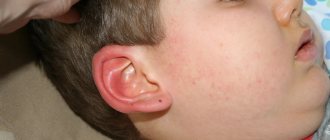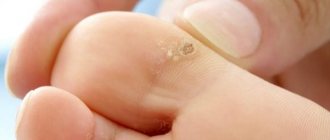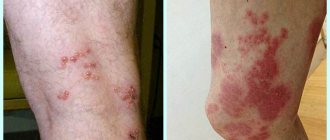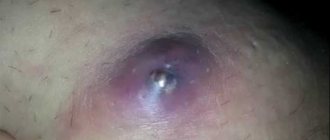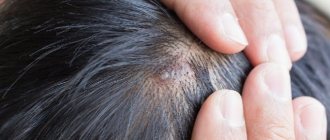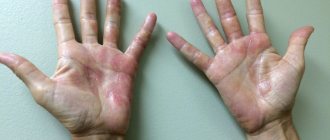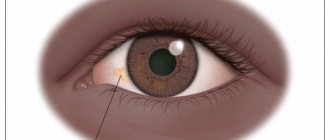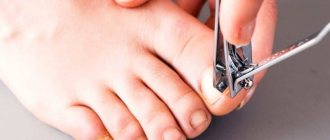Purulent lesions on the skin of the legs cause more discomfort than boils that occur on open areas of the body. The inflammatory process develops at the mouth of the hair follicle, so a boil on the leg is often a consequence of wearing dirty clothes or tight shoes. Homemade compresses are not enough to get rid of the infection. The body needs support in the form of vitamin therapy to strengthen the immune system, as well as taking immunoglobulins (antibodies), which are artificial immunity and replace the natural one until it gets stronger.
Home treatment methods for boils on the leg
A benign neoplasm on the leg causes discomfort to the patient when walking, causes pain and swelling.
Boils are most often localized on the lower leg, inner thigh, thighs, back of the foot, fingers, and knees. Due to the lack of hair, ulcers do not form on the feet.
Treatment depends on the stage of formation of the boil.
At home, you can treat ulcers without signs of a small abscess; therapy should be agreed with a doctor. Before treating the resulting boil, a diagnosis is carried out. The specialist collects anamnesis, conducts an external examination, and if there are complications and immune disorders, the doctor gives directions for laboratory tests - blood and urine tests.
Pharmaceutical ointments and solutions
During treatment, the feet provide quality care to the damaged area. Healing of a boil will be difficult due to excessive sweating, poor hygiene, and the presence of nearby wound surfaces on the skin area. Before treating an abscess, wash your hands thoroughly and try not to touch the problem area with your fingers.
| Boil development stage | Sequence of actions, medications for treatment |
| Redness on the leg, boil formation | Cut off the hair with scissors (shaving cannot be done due to the risk of infection). Treat the damaged area with an antiseptic (iodine solution, salicylic alcohol, Chlorhexidine). |
| The appearance of an abscess with a rod on the leg | Ointments that draw out pus are prescribed for treatment: Balsamic liniment (according to Vishnevsky), Ichthyol ointment. Heparin ointment will help relieve swelling and itching. If there is a strong pain effect, the leg must be smeared with pain-relieving gels Luan, Lidocaine. Medicines are applied to a bandage or wound. |
| Boil breakthrough | After opening the abscess, treat the wound on the leg with hydrogen peroxide. It is prohibited to apply brilliant green, iodine and other cauterizing substances to the wound surface. The skin around the injury is treated with syntomycin ointment. If there are complications, antibiotics are prescribed in the form of ointments: Levomecitin, Levomekol, Bactroban, Tetracycline ointment. The medications are active against Staphylococcus aureus, the causative agent of the disease. |
| Wound healing | For healing and regeneration of leg tissues after chiria, Panthenol, Solcoseryl, Eplan, Levomekol ointments are used. |
During treatment, it is not recommended to cover the damaged area with a plaster - the skin needs access to oxygen for speedy healing. Ointments for treatment can be bought at the pharmacy.
Traditional methods
Alternative medicine, the recipes of which have been tested by time, will help cure a boil on the leg.
| Ingredients | Cooking method | How to use, effectiveness | Efficiency, result of application |
| 1 tbsp. honey, 2 tbsp. flour | For treatment, mix the substances to form a cake. | Apply the product to the bandage and apply to the leg for 8 hours. | Accelerates the ripening and breakthrough of boils. |
| Onions (1 pc.), milk (0.5 tbsp.) | Grate the onion on a coarse grater and place in an enamel bowl. Add milk, prepare a decoction, cool, strain. | Apply the paste to the bandage and apply it to the boil overnight. | Promotes the breakthrough of boils on the leg, relieves abscesses and inflammation. |
| 0.5 tsp eucalyptus leaves, 150 ml. boiled water | Prepare a decoction for treatment. After boiling, simmer the liquid over low heat for 15 minutes, cool, and strain. | Clean the wound on your leg. | Used after a boil breaks out. The product has an antibacterial effect, removes pus, and relieves itching. |
| Onion (1 pc.) | Bake the onion. | Apply half an onion to a boil on your leg. | Accelerates the breakthrough and treatment of the abscess, draws out pus. |
| Pepper, onion, garlic, salt (in equal parts) | Mix the ingredients and place in the oven for 20 minutes. | The ointment is applied when cooled. Apply to a bandage or directly to a boil. | Acceleration of breakthrough and treatment of an abscess on the leg. |
| Alder and horseradish leaves | Rinse fresh leaves in water. | Apply to the wound on the boil | Antiseptic treatment of the wound, accelerates the healing process. |
| Chilled boiled water (1 tbsp.), honey (1 tsp.), calendula tincture (1 dessert spoon) | Mix the ingredients. | Apply to a compress and apply to the damaged area of the leg. | Drawing out pus, accelerating healing and treatment of the abscess. |
To relieve itching and inflammation will help:
- freshly prepared aloe juice for chiria localized on the leg;
- decoctions of chamomile, sage, calendula - prepared at the rate of 1 tbsp. raw materials for 1 tbsp. water;
- a mixture of finely grated laundry soap and baked onions.
Ointments and decoctions prepared independently for treatment should be stored in the refrigerator for no more than a day.
What is a boil in humans?
A furuncle (commonly called a boil) is an acute inflammation of the skin that has developed due to the activity of pyogenic bacteria (usually Staphylococcus aureus), localized around the hair follicle, affecting the sebaceous gland and nearby tissues. The lesion belongs to the group of pyoderma (purulent skin diseases), the general code according to ICD 10 is L02.
The pathology is characterized by a purulent-necrotic course and a clear division of stages:
- Initial, manifested by the formation of an infiltrate, increasing in size, accompanied by redness and soreness of the skin. Initially, a small nodule appears at the site of the hair follicle; on the second or third day, purulent contents appear in its center.
- Necrotic, accompanied by the formation of a rod, increased redness and swelling. The top of the boil noticeably rises above healthy skin, pain increases, temperature rises (sometimes up to 39 degrees), and symptoms of intoxication are present. The stage takes on average 3–8 days.
- An autopsy, during which the skin over the rod breaks through and the purulent contents come out. If the boil is located in an area with rough skin, self-opening may not occur and surgical intervention may be required.
After the cavity is freed from pus, healing begins, the timing of which depends on the size of the boil and the condition of the body. In some cases, complete cleansing requires installation of drainage.
Complications
The consequences of furunculosis are a cosmetic defect caused by scarring. In some people prone to the formation of keloid scars, traces of furunculosis may be significant, with tightening of the surrounding tissue. The formation of boils is especially dangerous in exhausted, weakened patients. In such patients, the disease is often complicated by an abscess or phlegmon (purulent melting) of the skin and subcutaneous tissue.
The appearance of boils on the upper lip is very dangerous. From here, infection through the venous and lymphatic vessels can easily spread to the vessels of the brain and even cause sepsis - a general blood infection.
Infection of the veins with a facial boil causes progressive inflammation, that is, thrombophlebitis. From there, the pathogens enter the sinuses (extensions) of the dura mater, causing a serious complication - purulent basal meningitis. It is accompanied by the rapid development of facial edema. Condensed veins are palpable and may be painful. Body temperature rises sharply to 40 degrees and above. Rigidity of the neck muscles is observed (the patient cannot tilt his head forward), headache, blurred vision and consciousness.
If the formation occurs on the neck, thigh, shoulder, it can be complicated by lymphadenitis - inflammation of nearby lymph nodes.
If staphylococcus gets into the blood, purulent foci may form in the internal organs - liver, kidneys and others.
Factors contributing to the development of complications:
- attempted squeezing, piercing or other impact;
- injury while shaving;
- irrational treatment with only ointments and other topical agents;
- location of the boil in the nasolabial triangle, on the nose.
In what cases is surgery required?
If the boil on the leg has not broken out within 6-7 days, you must contact a medical facility. In the absence of treatment, a complication in the form of furunculosis - multiple neoplasms - is possible. You should not self-medicate, pierce or squeeze out an immature boil, this is dangerous due to bacteremia - blood poisoning, with the subsequent development of sepsis. Using needles untreated with an antiseptic for these purposes will lead to infection in the wound.
Need advice from an experienced doctor?
Get a doctor's consultation online. Ask your question right now.
Ask a free question
The surgical intervention is performed in a hospital hospital setting. Using a surgical instrument, the doctor dissects the top of the boil, removes the purulent-necrotic rod, treats the damaged area of the leg with antiseptics and drains the wound. The operation is performed by a surgeon under local anesthesia; if there are no complications, the patient is discharged home the same day.
To avoid negative consequences, you should consult a doctor if the patient’s condition worsens after home treatment. Body temperature rises, the patient complains of weakness and pain in the problem area, and further growth of the tumor is observed.
Symptoms
The boil develops in stages, but its onset is sudden and bright. At the very first stage of the formation of a boil, redness of the skin, swelling and severe itching appear on any part of the leg. After some time, a nodule begins to form at the site of the abscess, which becomes dense and painful when touched. Every day the pain increases and becomes unbearable.
The boil begins to fill with pus, then bursts. When the pus begins to flow out, the painful sensations disappear. With painful symptoms may:
- headache;
- high fever, chills;
- weakness and fatigue appear;
- the skin begins to itch around the inflammation.
In all people, the inflammatory process occurs differently and therefore the size of the boil can range from a small dot to a walnut. The most complex boil formations are immediately accompanied by high temperature.
What can an abscess on a nail cause?
An abscess on the finger leads to suppuration under the nail, redness, and throbbing pain. The nail may simply fall out. When the tendon becomes inflamed, cells die and the finger becomes less mobile. When the abscess becomes complicated—purulent inflammation spreads to the fatty tissue of the hand—the temperature rises, the hand hurts greatly, the fingers become stiff, and general health deteriorates.
Medications
For example, Vishnevsky ointment, Levomekol. Traditional medicine also suggests applying aloe or Kalanchoe leaves to the head of the boil as an alternative. The ointment is applied to a clean bandage and applied to the affected area, after which it is tightly wrapped with a cloth or bandage. It is recommended to change this dressing every few hours.
After opening the boil, it is necessary to remove the pus and the core from the wound. This procedure is carried out with clean hands (it is better to treat them with hydrogen peroxide). When all the pus has come out, the rod and its processes are removed, the wound is treated with hydrogen peroxide, and then antiseptics (iodine, brilliant green) are applied to its edges and the skin around it.
To prevent new formations from arising, it is necessary to lubricate the skin around the wound with antibacterial agents (Zinc or Syntomycin ointments). Sometimes an abscess on the leg can be recurrent, when after the healing of one boil another (possibly several) appears nearby. Then doctors diagnose furunculosis.
This condition is very undesirable, since its treatment is significantly complicated and delayed. In this case, the patient must undergo a course of drug therapy. It consists of using the following medications: Immunalantibiotics (to eliminate infection): Cefixime, Amoxiclav; immunostimulants (to increase immunity): Immunal; blood purification products; vitamins
This treatment is carried out in a hospital under the supervision of the attending physician. He determines the duration of therapy and prescribes a list of necessary procedures and medications. If the described methods do not help and the development of the disease threatens sepsis, then a surgical treatment method is used, which involves opening the abscess and clearing the cavity of pus.
How to provide first aid for an abscess
If your big toe breaks near the nail, or with other inflammations, you need to wash the skin with warm water and soap. It is useful to take baths with dissolved potassium permanganate, salt, soda, and herbal decoction. Dry, treat the lesion with an antiseptic (Miramistin, Chlorhexidine, hydrogen peroxide). And apply an anti-inflammatory ointment such as Vishnevsky, Levomekol or Ichthyol to the suppuration under a non-pressure, fixed gauze bandage. They will draw out pus and treat inflammation.
The compresses are changed periodically while the nail is sore, according to the instructions for the drug. They are sold at any pharmacy without a prescription. If it is difficult or impossible to make bandages, especially when treating a child, sprinkle Baneocin on the suppuration on the leg near the toe.
It is forbidden to squeeze out an abscess in self-treatment, especially by cutting it or the nail with any auxiliary instrument. You need to wait until the formation breaks through and begins to open on its own. Then remove the pus from the leg with alcohol, and continue applying the ointment until healing.
If it breaks out on your finger or on your toenail, you should not warm the suppuration with a blue lamp or by applying a hot egg or heated cereal in a bag.
To avoid even more serious consequences of a finger abscess, you should know how to provide first aid. You should not puncture a blister containing pus, as this can cause infection in an open wound or cause blood poisoning.
To relieve inflammation, you can prepare a warm bath with salt, soap or chamomile. The affected foot should be dipped in this decoction several times a day. After the procedure, wet the limb with a towel and apply aloe leaves to it.
If after three days the condition does not improve, it means that the inflammation has spread to the deeper layers of the epidermis and medical intervention is required.
Clinical picture
The development of the boil occurs sequentially and has three stages:
- development of infiltration;
- suppuration and necrosis;
- healing.
As such, the incubation period of furunculosis is difficult to determine, since in most cases the disease is caused by its own microorganisms that have long settled on the skin. Initially, a raised compaction (infiltrate) appears around the hair follicle. It is bright red in color, has unclear boundaries, is slightly painful, or is accompanied by a tingling sensation.
After one or two days, the infiltrate thickens and expands, taking on the shape of a tumor and becoming painful. Nearby tissues swell, especially if a boil develops on the face.
After three to four days, the next stage develops. The infiltrate increases to 1-3 cm, in the middle of it a core is formed, consisting of dead and disintegrated tissue. A pustule forms at the top of the boil, which looks like a white head. The formation of a purulent-necrotic core is due to the fact that active inflammation occurs in the center of the follicle, which results in massive death of immune cells recruited to fight the infection. Pus consists of remnants of leukocytes, destroyed microorganisms, and decayed tissue of the hair follicle.
At this stage, the boil resembles a cone covered with smooth, stretched skin. The formation is painful, especially when located in the external auditory canal, scalp, fingers, or shins. If there are multiple ulcers, the patient’s body temperature may rise to 37-38 degrees. Symptoms of intoxication (poisoning) appear: weakness, headache.
This stage lasts about 3 days. Then the pustule opens, pus is released through the top of the follicle, sometimes with blood, and then a yellow-green purulent “plug” comes out - a necrotic core. In place of the abscess, an ulcer forms, which has uneven edges and a “undermined” bottom. It is filled with necrotic masses.
After cleansing the follicle cavity, the patient’s condition improves, the temperature returns to normal, and the pain goes away. Within a few days, the ulcer cavity is filled with granulations, that is, it heals. A bluish-red scar forms, which then fades. The total duration of such a cycle is about 10 days. Especially large boils form in diabetes mellitus.
Recurrent furunculosis is accompanied by the formation of a new abscess after the previous one has healed. This condition most often occurs in adolescents, young men, and young adults with an allergic predisposition (sensitization) to staphylococci, as well as in patients with diabetes, alcoholism, and diseases of the stomach and intestines. Often a recurrence of the boil occurs with pediculosis (lice) and scabies.
When the course of the disease is erased, the infiltrate does not suppurate, and a necrotic core does not form.
Boils can form on any part of the body, except the soles and palms, where there are no hair follicles. Favorite sites of infection are the back of the head, forearms, lower back, abdomen, buttocks and lower extremities.
Acute furunculosis lasts from several weeks to two months. It is accompanied by the appearance of numerous boils. Chronic furunculosis is characterized by a few follicles that appear constantly or with short breaks over several months.
Causes
A boil is dangerous because it can affect even a relatively healthy person with a strong immune system.
Most often, this formation is localized in areas of the skin that are most exposed to friction and mechanical stress. First of all, such areas include the neck, lower back, knee bends, armpits, nose and ear, as well as legs.
According to statistics, boils form in men more often than in women. Chirp appears on his feet. This is due to the fact that men are more prone to bad habits than women, which seriously weaken the immune system. At the same time, women, especially those who are overweight, often face this problem.
Boils may vary in size. For some people they look like a regular pimple, while for others they can grow to the size of a tennis ball. If appropriate measures are not taken in time, the inflammatory process can very quickly spread to other areas of the skin and develop into furunculosis.
Experts call representatives of the group of coccal microorganisms the main culprits for the appearance of an abscess on the leg. Most often it turns out to be golden, less often - white staphylococcus. Diseased bacteria can live on the skin for a long time, but only until the moment when the body’s immune forces weaken to such an extent that the microorganism can manifest itself. And when unfavorable conditions are created, staphylococcus through its activity can destroy the protective function of the skin.
The following factors can contribute to the penetration of pathogenic microorganisms into the skin:
- unbalanced diet;
- weak immunity;
- hypothermia;
- chronic diseases;
- avitaminosis;
- skin damage and injury;
- increased sweating;
- neglect of hygiene rules, as well as wearing dirty clothes for a long time.
If you do not want to fight boils, then you need to do everything to prevent the occurrence of all the above factors.
Treatment methods for leg abscess
A purulent seal on a limb is eliminated in two ways: conservative and surgical. Therapy in mild cases of the disease is carried out by doctors on an outpatient basis; severe necrotic formation on the leg requires inpatient treatment.
Antibiotics and other drugs for conservative treatment
After confirming the diagnosis, the doctor determines the tactics for eliminating the abscess that has formed on the leg. In conservative therapy, penicillin antibiotics are used: they act on streptococci and staphylococci. Pharmaceutical drugs include Amoxicillin, Oxacillin, Ampicillin.
Antimicrobial therapy is prescribed according to laboratory tests and the results of studies on sensitivity to microflora. The dosage of antibiotics to eliminate an abscess in the legs is selected according to the body weight of the patients; for a child it is reduced several times.
To locally relieve the symptoms of inflammation, Vishnevsky's remedy, Levomekol gel, and ichthyol ointment are used. They disinfect the purulent focus, reduce the proliferation of pathogenic microflora, skin defects on the leg heal faster after using the drugs.
Surgery
Surgical intervention in the process of treating an abscess is based on opening the purulent surface and releasing the cavity from the contents. The operation is performed under local anesthesia; the doctor injects an abscess located on the leg with anesthetics.
The doctor cuts the abscess crosswise, the contents flow out of the capsule, and the pathology site is washed with antiseptics (hydrogen peroxide). The surgeon does not suture the cavity to prevent repeated suppuration. A piece of sterile latex glove is inserted into the operated area for drainage; it will ensure that the resulting substance drains out.
For preventive purposes, to reduce the likelihood of an abscess, oral antibacterial drugs are prescribed; they suppress the reproduction of organisms. For local treatment, compresses with hypertonic solutions and antimicrobial ointments are used. Recovery occurs in 7-14 days.
Is home treatment possible?
At home, therapeutic measures are taken to eliminate an abscess located on the leg if:
- the abscess lies superficially;
- the disease is at an early stage.
Traditional medicine involves the use of a warm bath to relieve the symptoms of an abscess: the patient immerses the affected leg in liquid, and sea or table salt is added to it. The products draw out pathological contents, the duration of the procedure is from 5 to 10 minutes. After opening the abscess, the area is treated with antiseptic drugs.
A compress of mumiyo is applied to the abscess, then a bandage of sea buckthorn oil is applied, and left for 4-5 hours to obtain a therapeutic effect.
Abscesses on the legs are opened by Vishnevsky's liniment with fir oil, they are taken in equal proportions. The mixture is applied to the sore leg and covered with compress paper. The bandage is fixed to the area affected by the abscess with a bandage and changed every 8-12 hours.
You can alternate traditional methods of treatment with a plantain mask. The leaves of the plant are crushed to form a paste of uniform consistency, the product is applied to the surface of the boil, cling film and gauze are applied to the leg.
Doctors do not advise self-medication for abscesses of the foot, leg, thigh: the infection quickly spreads into the deep layers of tissue and penetrates the bloodstream. Advanced stages require pathogenetic treatment; home remedies are used as an addition to the main therapy for formation on the leg.
Localization of abscesses in the finger area and signs
The infection that gets under the epidermis begins to develop very quickly, itching, burning, swelling and pain appear. If inflammation develops further, pus begins to collect under the skin. If the joints are affected, the affected area becomes hot, inflamed, severe pain appears, and the finger cannot bend.
Symptoms such as fever and deterioration in health are possible. A skin abscess near the nail goes through several stages:
- Penetration of infection into the layers of the epidermis. As a result, the skin turns red, becomes swollen, and pain and itching appear.
- Next, an inflammatory process occurs, stripes or blisters with pus are formed.
- Pain appears.
- The finger hardens and stops bending.
A common variant of inflammation in the area of a toenail or finger is when it breaks out cutaneously or subcutaneously. Causes redness, pain when pressing on the formation, swelling of the tissue in the nail growth area.
If it breaks out under the toenail, the existence of an abscess is accompanied by a feeling of pulsation, pain, and swelling of the finger. Pus collects under the plate, preventing its free outflow; treatment is necessary.
If suppuration on the toe has affected the nail fold (the skin around the nail breaks), it is localized on the free edge of the big toe, causing pain, a feeling of tightness, and suppuration. A plate that is trimmed or sawed improperly begins to change its growth trajectory over time, growing into the side edge of the roller.
When an abscess or abscess is localized between the toes, if there is no pus, but there is itching, redness, skin separation, unpleasant odor and weeping, it is more advisable to suspect a mycotic infection rather than felon. Treatment is carried out by a dermatologist, mycologist.
Causes of boils on the leg
A boil on the leg occurs as a result of the active proliferation of bacteria that causes an inflammatory process.
Most often, this problem has the following causes:
- a person has a weak immune system and is easily attacked by viruses and bacteria;
- a person is regularly exposed to infectious diseases;
- a person suffers from hypothermia;
- unhealthy diet and bad habits;
- excessive friction of the skin on the leg;
- increased sweating, which leads to blockage of the hair follicle;
- improper hygiene;
- diabetes;
- damage to the skin.
There can be a large number of factors that contributed to the formation of a boil on the leg. Therefore, each person must consider the reasons individually, depending on the characteristics of the body.
Disease prevention
Since the development of a boil on a child’s leg is most often associated with weakened immunity and non-compliance with personal hygiene rules, parents are obliged to pay due attention to the prevention of this pathology. The main preventive methods are presented:
- strengthening the immune system;
- bathing the child regularly and avoiding contamination;
- timely treatment of skin damage;
- minimizing hypothermia, stressful situations and other factors that may not have the best effect on the state of the child’s defenses.
With a responsible approach to the treatment and prevention of furunculosis, you will be able to save your child from such unpleasant problems forever. Stay healthy!
A boil in a child is not only an unpleasant occurrence, but also a rather dangerous disease. The appearance of boils indicates a deterioration in the general physical condition of the child. In addition, lack of timely medical care can lead to serious complications. That is why and for a number of other reasons, a boil in a child requires close attention and a responsible attitude of parents. Self-treatment of boils in children is excluded, since the effectiveness of the measures taken directly depends on the accuracy of the diagnosis. Not all medical techniques and methods can be used to treat children. Contacting a pediatrician will help you avoid many problems and complications.
Complications of boils and carbuncles
After a large boil and, especially, a carbuncle, a scar remains on the skin. It will not completely disappear, but over time it will fade and become less noticeable. To improve cosmetic results, your doctor may prescribe:
- corticosteroid injections - helps smooth out raised scars;
- pressure bandage - helps to smooth out and soften the scar;
- Plastic surgery.
You can also use makeup to hide the scar. There are special products for camouflage makeup that are sold in pharmacies without a prescription.
Infectious complications of boils and carbuncles
Sometimes bacteria from a boil or carbuncle can spread to other parts of the body, causing secondary inflammation. Most often, this complication is phlegmon - diffuse purulent inflammation of the deep layers of the skin. The following complications occur less frequently:
- impetigo is an extremely contagious skin disease in which multiple pustules appear on the body;
- septic arthritis - infectious inflammation of the joints;
- osteomyelitis - inflammation and destruction of bone tissue;
- endocarditis - inflammation of the inner lining of the heart;
- septicemia - blood poisoning;
- brain abscess, meningitis - purulent diseases of the brain and its membranes.
To treat these complications, antibiotic therapy is used, and surgery is often required. Septicemia, meningitis and brain abscess may require treatment in the intensive care unit.
Cavernous sinus thrombosis
Cavernous sinus thrombosis is a very rare but potentially life-threatening complication of boils and carbuncles located in the face, ear, and nose. Due to the peculiarities of the blood supply, from these zones the infection very easily enters the cavernous sinus - this is a formation from the dura mater, which is connected to blood vessels. From the cavernous sinus, the infection quickly spreads into the tissue of the orbit. The following symptoms are characteristic of cavernous sinus thrombosis:
- acute and severe headache;
- swelling and protrusion of the eye;
- intense pain in the eye.
Why is an abscess dangerous?
With timely, proper treatment, an abscess on an arm or leg does not pose a danger, especially if the baby’s immune system is working well. Otherwise, the following complications may develop:
- Tenosynovitis. Infection of the tendons, resulting in immobility of the affected finger.
- Phlegmon of the hand. This is an acute inflammatory process that spreads to the fatty tissue of the hand and is accompanied by the accumulation of pus. It causes severe pain and can only be treated with surgery.
- Sepsis. The most dangerous consequence is caused by blood poisoning. It is rare, but without qualified medical care it can be fatal.
- Osteomyelitis. Purulent infection affects bone tissue. Sometimes complete amputation of the affected finger is required.
